Monday, 26 January 2015
It’s the 26th of January here and for people in Australia that means Australia day which is a public holiday. Yay! The public holiday celebrates the landing of the First Fleet on the continent way back on the exact same day in 1788. For those that don’t know it, the First Fleet comprised quite a few ships carrying a whole bunch of criminals, some military to supervise them and a couple of free settlers of questionable sanity. The first sensible act upon arriving on this continent was to send ships off to obtain more supplies from the nearest English colonies. It quickly became evident that a bunch of criminals from urban areas of the UK really knew very little about farming in a strange and unfamiliar environment. Needless to say, the whole lot of them almost starved.
I have a wide streak of irreverence so for me the 26th of January is to be celebrated for the national government funded and commercial free youth radio station which is broadcast across most of the continent: Triple J – because that radio station hosts the Hottest 100 countdown. As a fun fact listeners vote over the Internet for a limit of 10 songs per listener and just to show how much attention the countdown receives here, there were more than 2,000,000 votes. That’s right 2 million votes. That’s a whole lot of votes. In fact it is the biggest music poll anywhere on the planet. And yes, I’m outing myself here as something of a youth music tragic because I’ve been listening to the countdown and also the radio station since 1994. Long live the government funded commercial free youth oriented music radio station Triple J! That alone makes me happy to pay my taxes, it does.
Back to the real world and in breaking farm news: The first steel step has been installed for the cantina shed. It is looking good and most importantly of all, steel is far less prone to bouts of spontaneous combustion during a bushfire than a treated pine step (which was the material it replaced)!
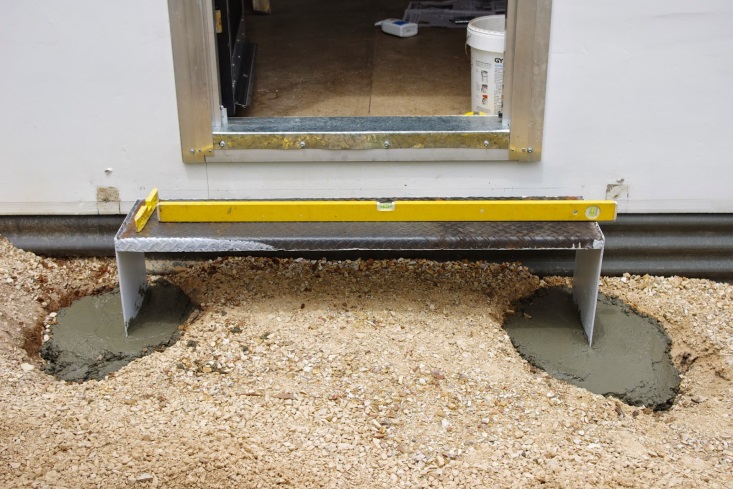 |
| The steel step is cemented into position for the cantina shed |
The yellow spirit level sticks as well as the pencil mark on the shed itself ensures that the step is level on both axes as well as being visually level with the cantina shed itself.
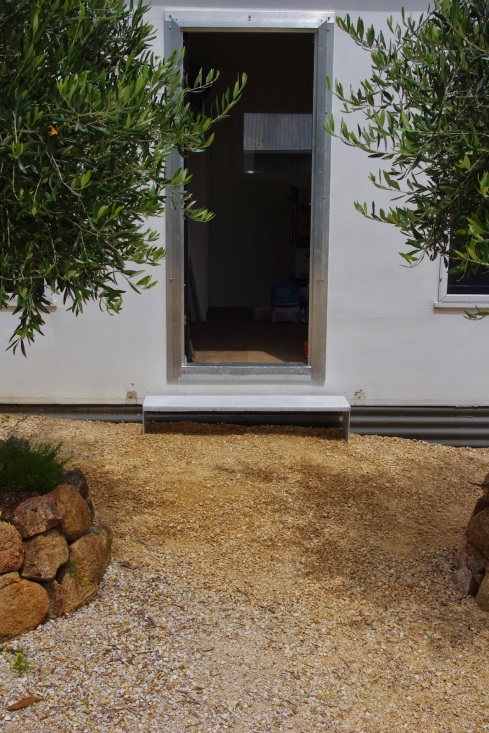 |
| Another coat of undercoat is painted onto the cantina steel step |
The concrete stairs reaching from the courtyard to the future strawberry and potato beds have now also been finished this week. I’ve even brought in enough trailer loads of woody mulch and mushroom compost mix to establish the new larger garden beds on either side of those concrete stairs. That particular mix needs to settle over the next few months before I can place plants into it, but eventually it will be a massive garden bed of flowers, herbs and mixed vegetables. It may be of some interest to those readers that are interested in all things soil to see just how thickly I apply such a mix. Very observant readers will also notice the low tech method I use to dry my clothes!
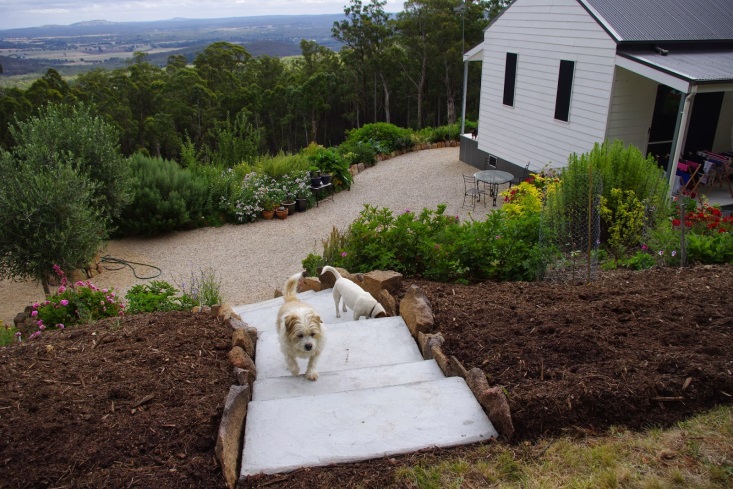 |
| The concrete stairs to the future potato and strawberry beds are now finished and the dogs approve |
Oh, well done Hilltop hoods and Peking Duk – sorry everyone who has no idea what I’m talking about as I’m listening to the Triple J countdown as I write this.
When you live on the side of a mountain, you really need stairs. So this week I’ve also commenced constructing the steel stairs which will replace the final combustible item of building material which are attached to the house. The steel construction involved welding four individual steps with supports which will replace a timber set of stairs currently attached to the house. I had an interesting experience whilst welding the stairs because after a few hours I’d drawn so much electrical energy from the solar power system and on such a hot day that the thermal overload safety switch kicked in on the inverter (the machine that converts battery DC power to mains AC power) and for only a second time in my experience the entire system shut down. And, I was let with no power at all – nothing…
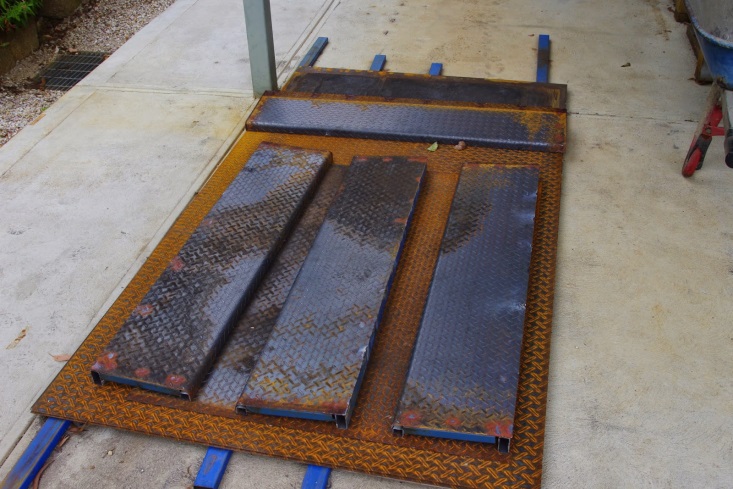 |
| Four new stair treads have been manufactured for the new stair treads |
Pah, not saying I picked it, but I definitely picked it: Chet Faker, number one for his track “Talk is cheap”. Oh sorry, apologies again to everyone who has no idea what I’m talking about.
The weather has turned cooler here today and for the next week, however bushfires are still on my mind so I cut a steel sheet to perfectly cover the solid timber door which will be used for the future firewood shed.I later refitted the handle and deadbolt lock.
 |
| A steel sheet has been cut this week to cover the solid timber door which will be used for the future wood shed |
The apples are starting to ripen this week so I’ve been busy making both apple cider and apple cider vinegar. It is a good indoor activity for when the afternoon temperatures are scorching. Those two products must be the easiest things to make. The apples are simply cut into eighths and then added to a food processor so that they can be blitzed. You don’t actually need to blitz them, but the increased surface area speeds up the entire process. For every bowl of apples blitzed I then add half a lemon and a bit of water. The lemon is there to provide citric acid which stops the apples from going brown. If apples go brown – and they will very quickly even if cut with ceramic or plastic blades – it doesn’t actually affect the taste of the cider, it is more a visual thing than anything else.
 |
| Me looking unimpressed after an hour of cutting fruit for apple cider vinegar |
Add a bit of water and some yeast – if you want – and after a few weeks the whole mass will commence fermenting. Initially, it should look like this:
 |
| Apples in a plastic bucket at the beginning of their journey into apple cider and apple cider vinegar |
Some of my favourite local native trees are the Blackwood’s (Acacia Melanoxylon) because they are broad leafed, long lived, produce valuable furniture timber, also they produce great shade and fix nitrogen – in combination with certain bacteria – from the atmosphere into the soil so that it is available for other plants to consume. In parts of this state they form the over storey trees. Also the Japanese natural farming guru Master Fukuoka (him of the One straw revolution fame) used these as his favourite nitrogen fixing tree.
 |
| Blackwood trees producing copious seeds in Cherokee |
The trees themselves produce copious quantities of seeds as can be seen in the photo below:
 |
| Blackwood seeds on the tree |
I propagate these trees and plant them about the farm. I headed out today to pick a bucket full of seed pods and will shell them over the next few days as time permits. The shelling process is not dissimilar from that of shelling pea pods.
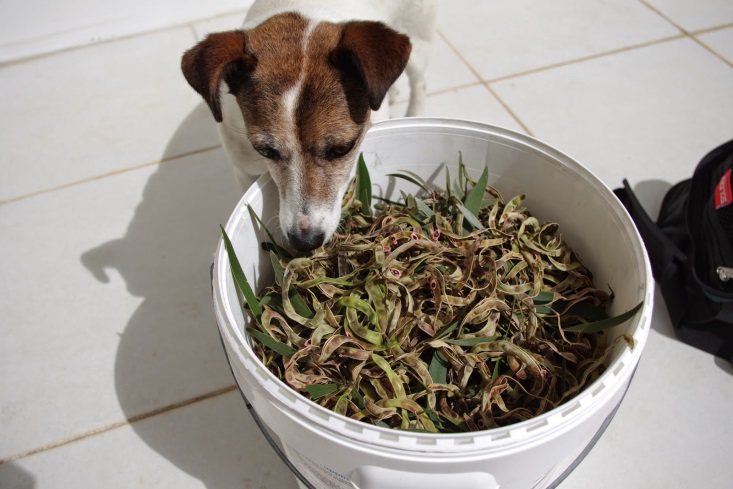 |
| Scritchy the boss dog investigates the Blackwood seed pods collected today |
As well as collecting Blackwood seeds, I’ve also been collecting seeds from the many Tree Lucerne (Tagaste) trees on the farm also with the intent to propagate them.
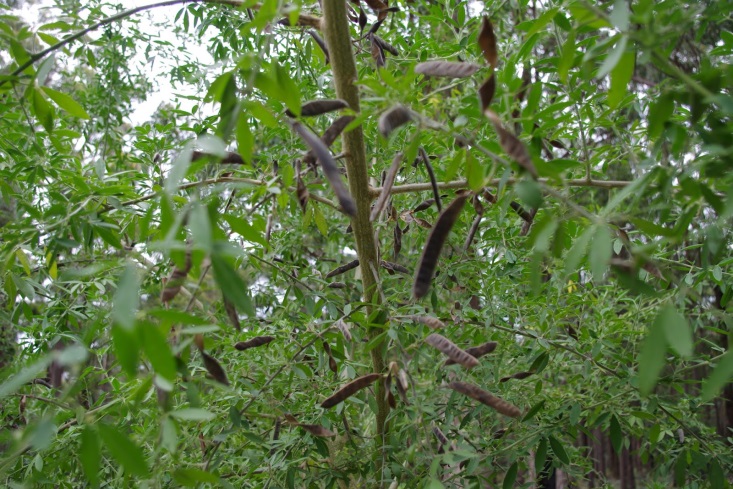 |
| Seed pods on the tree Lucerne tree |
Those trees are so named because not only are they exceptionally hardy in very challenging conditions, but the leaves contain more than 20% protein and are exceptionally good hassle free fodder for chickens, pigs etc. If you are not growing them and you could be, then I have to ask the question: Why not?
It might be my imagination and I certainly could be wrong, but autumn looks as though it has arrived early this year. The recent massive continent wide monsoonal storm has dumped a huge quantity of water in the centre of the continent and things there have become greener. Here though, the Araucana chickens have started moulting and gone off the lay which they normally do in autumn and some of the fruit trees are showing a touch of autumn colour. It is weird because a year ago and in two weeks time I was facing a serious bushfire threat.
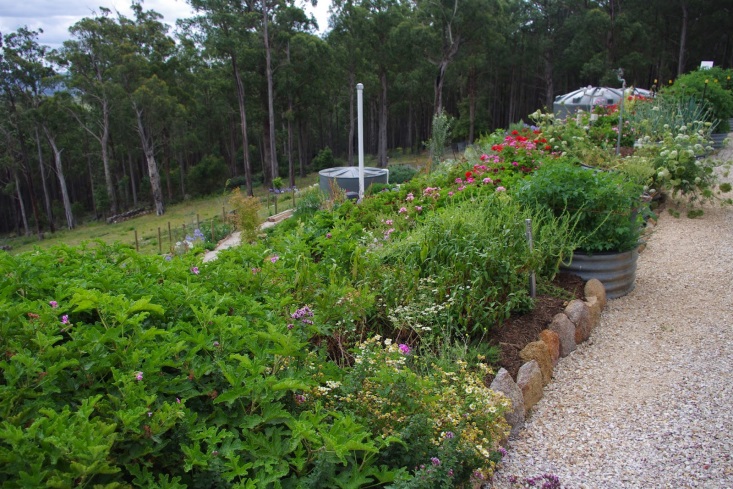 |
| Autumn looks as though it may have come early this year |
How did I get here?
My experiments with growing food crops quickly progressed in the small inner city terrace backyard and I learned many useful lessons. Unfortunately I couldn’t escape the fact that I quickly ran out of space. The backyard soon became much too small and crowded, so I yearned for a larger chunk of land.
Now, anyone who has tried to purchase land in Australia will know that land is expensive and the closer that land is to a major city, the more expensive it is. How anyone can make a profit in agriculture in this country with land prices the way they are is a complete mystery to me.
Anyway, so I looked around for a long time before realising that the only reason that land would be cheap was because no one else would want it. Thus with that thought at the back of my mind, I stumbled across the block of land here.
It had lots of things going for it such as the high risk of wildfire which really seemed to scare people for some strange reason. As another positive for me, the owners refused to spend any money at all on advertising the sale, so to say that the property was really hard to find was a true understatement.
On a serious note, being on the side of the saddle of an extinct (hopefully) volcano, the soils were deep, and the volcanic massif reared out of elevated plains so was an excellent cloud catcher and thus rainfall was more reliable than other parts of the state.
The title also stated that it was permissible to build a house on the land, so I took a gamble and bought it.
To be continued…
Posted by Cherokee Organics at 21:36 43 comments: ![]()
Monday, 19 January 2015
For those who may be unaware, yesterday’s early blog post was an entry to a competition seeking the silliest fake press release relating to a fictional future energy source. I trust that everyone had a good laugh and enjoyed it. We now return to our regular programming:
Well, it has been a most interesting week here as the tropical monsoon slugged its way from the northern and hence very tropical part of the continent (remember everything is upside down in the southern hemisphere) to dump more than an inch of rain here over a couple of days. The rainfall was very well received, the water storage tanks are now full and the farm has received more rain this January than the long term average. Nice work! Incidentally, as the weather stands today, it is still 1’C degree hotter this January than the long term average.
The monsoonal storm clouds put on quite the show too:
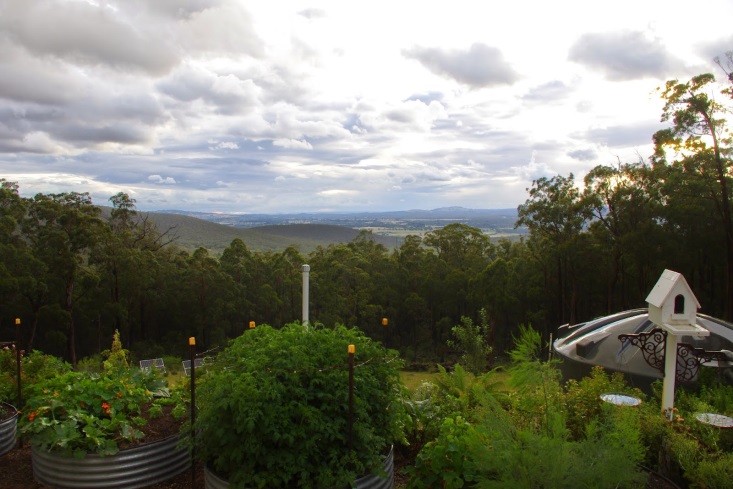 |
| Tropical monsoon storm clouds begin to roll over the farm |
Outside work at the farm slowed down as the constant drizzle kept me inside. Don’t feel too bad for me as I took some time off and relaxed and undertook a most serious and important search for the best apple cakes in the area. It is a tough job, but then someone has to do it! The results are in but I must confess that a bit more research may still yet be required.
The concrete stairs gained two more steps during the week. Those new top two steps were quite long and I now think of them more as landings than steps as they extended well beyond the concrete formwork. There are maybe, three more steps and then that stair project is finished. The stairs are leading from the courtyard up a steep slope and into an area which will contain a future strawberry and potato bed. There is still quite a lot of work to go on a few different projects before either of those garden beds materialise. It always surprises me but one project has to be completed before the next can be commenced – and that really is how it goes.
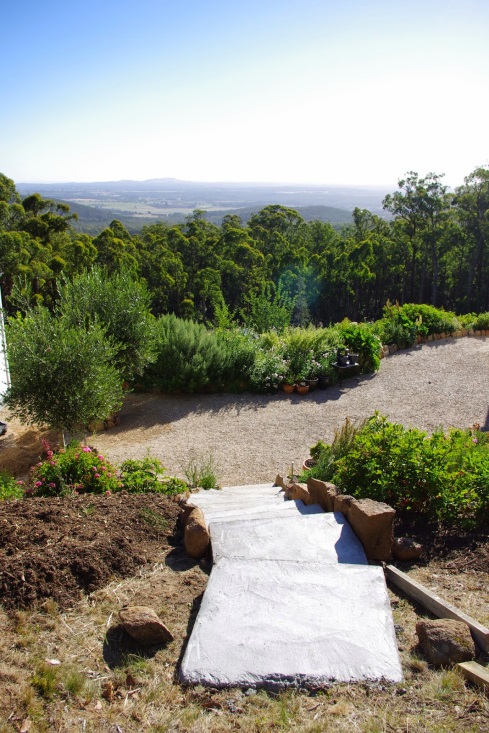 |
| The new concrete steps climb ever higher up to the future strawberry and potato beds |
The photo above from today also shows just how well the forest received the recent rainfall as the Eucalyptus Obliqua (Messmate) trees are displaying a very lush canopy for this time of the year.
On a completely different note: a lot of guys have trouble asking for help. I’m not one of those guys. However, being a jack of all trades, master of some, creates problems for me every now and then. Late last year I sought out a few quotes to get a supplier to build a set of steel stairs for the house. If you live in a bushfire prone area, then steel stairs are a really good idea, because they don’t burn if a bushfire just happens to pass through the area that you live in. The entire house has non-combustible external surfaces except for one set of stairs which was made of treated pine. Those stairs were a temporary measure just to see whether they got any use. Steel stairs are needless to say – expensive and not lightly installed on a whim. The temporary stairs ended up being heavily used, so I thought to myself that they’d make a good permanent addition to the household. So, thus I sought some quotes from steel stair manufacturers.
However, when I received the quotes late last year, I was actually shocked at the quoted prices. The cheapest was $1,800 for one set of just four steel steps. Surely, the cheapest supplier must have thought – even though I’d dealt with them before – that I was a complete idiot! So I did what any jack of all trades does and purchased the checker plate steel with which to make the steps myself. The $200 of steel I ended up purchasing also provided enough left over steel to build a second and much smaller set of stairs for the cantina shed.
So this week I started building the first step for the cantina shed.
The checker plate steel had to be cut into the correct tread width (i.e. the bit where you put your foot). I used an angle grinder with a steel cutting disc to cut five separate treads – one for the cantina shed set of stairs and another four for the house set of stairs.
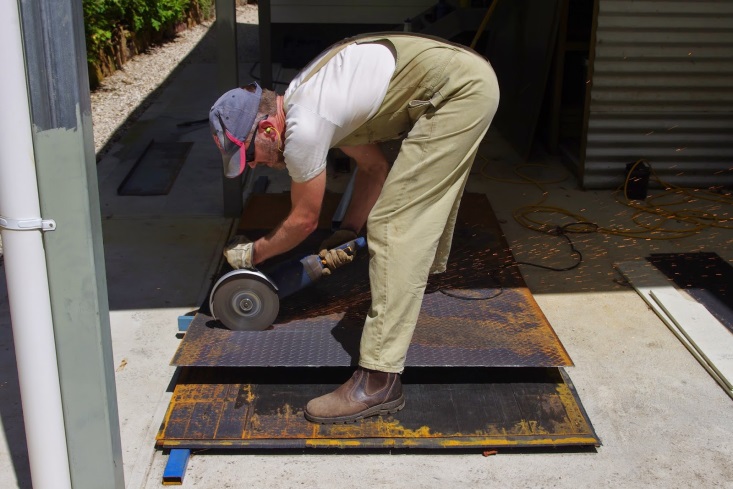 |
| Using an angle grinder to cut the checker plate steel into five treads |
The steel stair manufacturers have wonderful machines that can produce perfect bends and folds in the checker plate. Unfortunately, I don’t possess one of those machines so I had to fold the edge of the steel step the old school way. This involved heating up the flat steel checker plate:
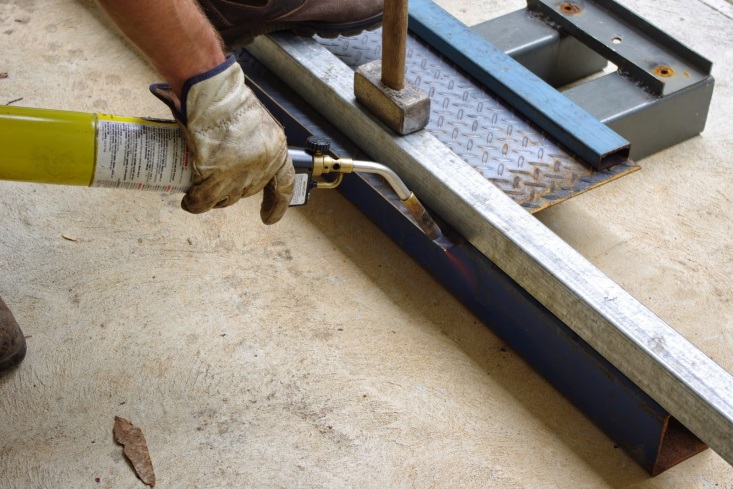 |
| Heating up the steel checker plate |
Then the fold is created in the steel step by bashing the hot steel with a small hand mallet a whole bunch of times, whilst trying to keep the fold on a completely straight line. This week after cutting and folding five of those stair treads, I have developed a truly newfound respect for the blacksmiths of yore!
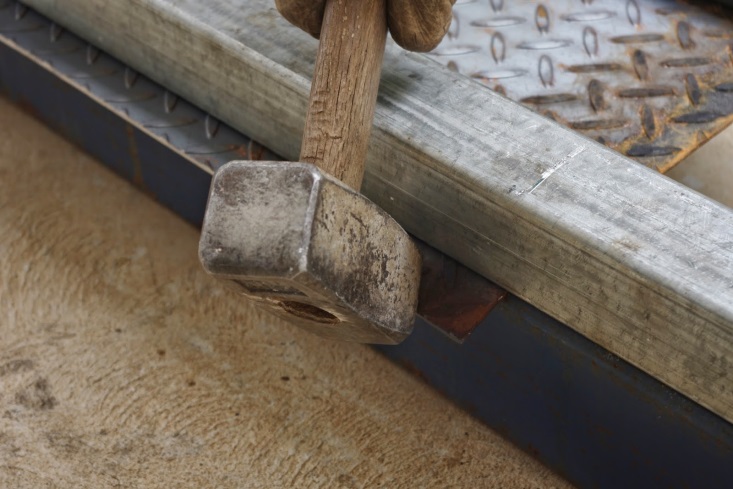 |
| Folding the hot steel step tread using a mallet |
I then welded – using solar electricity and a welder that is almost as old as I am – the folded step and under tread steel step supports to some very heavy duty side supports. Once that was complete I gave the new steel step a good coat of steel undercoat paint and left the paint to cure.
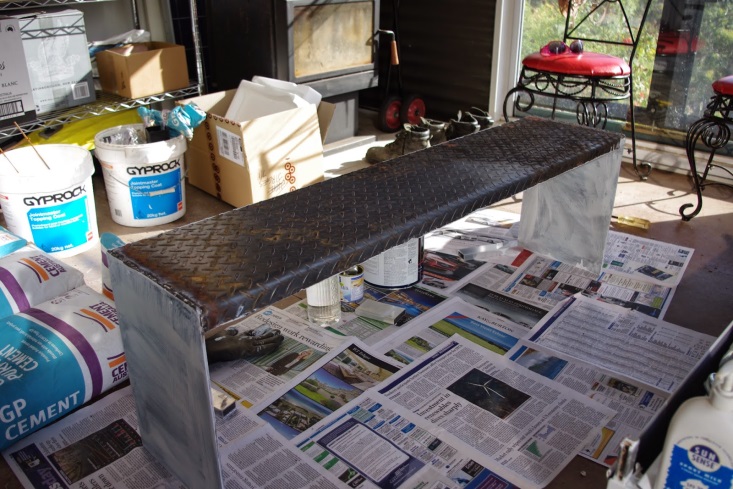 |
| Steel step with undercoat curing in the cantina shed |
That step was built for the cantina shed in order to replace an existing timber step (and thus highly flammable) and although the completed step looks quite high sitting in the cantina all by itself, over half of those heavy duty side supports will be embedded in concrete so that the whole step doesn’t tip over or collapse when you put your foot on it. This is an important requirement for a step if I must say so!
I was pretty chuffed with how the fold in the step turned out as I had never tried that particular technique before. As a mate of mine says: “It’s as good as a bought one!”
Incidentally the photo shows a small view of the inside of the cantina shed too.
Enough of steel and other stair stuff and back to plant news! The tomatoes are growing very strongly and the difference between the tomato bed planted in mid-October and the one that was planted in early November is even more marked than ever before. The mid-October bed which is towards the front of the photograph below – just behind the asparagus bed – has plants that now reach well above my head. The November bed which I’m standing next in the photograph is a whole lot further behind and the plants barely reach my shoulder.
Both tomato beds are now full of flowers and simply waiting for the bumble bees and other pollinators to get on with their jobs.
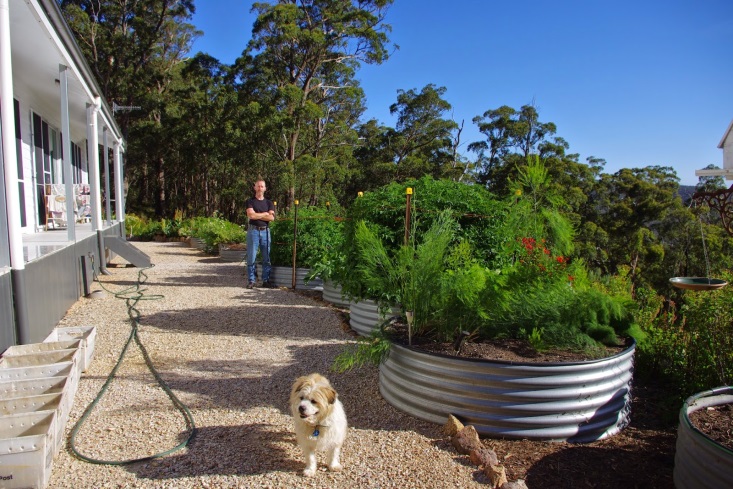 |
| I’m standing next to the early November tomato bed, whilst the dog is much closer to the much taller mid-October tomato bed |
As this week was quite wet, I’ve been using the forced inside time to collect and dry seeds from various plants. Broad beans, red and yellow leafed lettuce, dill, Russell lupins as well as others have been collected this week. Long term readers may have already realised that I like saving a buck where I can and seed saving is an easy way to do this. Already a lot of the plants that I grow here now come from either self-seeded specimens or previously saved seed.
 |
| dill, red and yellow leaved lettuce heads collected in a bucket for drying |
Saving seed is almost idiot proof – which appeals to me – and I collect the flower heads once I’ve judged that the seeds have matured (i.e. they look dry). I then store them in a dry area and then many days later use a colander (i.e. a bucket with lots of small holes in it) to shake the seeds out for collection. The seeds are then stored in a paper bag which is then kept in a cool and dark area (like a cupboard). The left over heads are thrown onto the garden where any seeds not collected usually sprout. Easy.
How did I get here?
About a decade ago, I noticed that food – particularly fresh food – started tasting bland. At first I thought that I was mistaken in this belief. Then as time went on, things didn’t get better as more fresh food items tasted bland to me. It was like eating cardboard and I really do like the taste of ripe fruit. It was a complete disappointment to me.
This change, led me to commence sourcing my fruit from orchards and other growers. This solution worked for a year or two, but then that fruit started tasting bland too. Not being shy, I asked many of the growers why this situation was happening. The reasons were many and varied, but largely it boiled down to the fact that the fruit had to be picked greener (i.e. less ripe) than previously as it travelled better. Ripe fruit does not travel or store well because it is much softer than unripe fruit and apparently consumers these days want better looking fruit as distinct from better tasting fruit.
If people were happy with this situation, who am I to argue?
In my usual style, I decided then and there: how hard can growing your own fruit and vegetables be?
Well, the answer is quite hard indeed!
In the early years I made many mistakes – some of which were just laughable. I truly had no idea so began the long process of reading about growing stuff, soils, water, seasons. I looked into organic systems, bio-dynamics, industrial agriculture. This was a seriously big topic.
My lady had an intriguing book in her collection: Introduction to Permaculture. I read that too and started to get the idea that a wholistic approach to growing stuff would be not a bad idea.
And once I’d run out of space in the back yard of the terrace house, I secretly – well perhaps not so secretly – yearned for more space.
To be continued…
The temperature outside here at about 9.30pm is 17.7 degrees Celsius (63.8’F). So far this year there has been 66.8mm (2.6 inches) of rainfall which is up from last week’s total of 37.2mm (1.5 inches).
Posted by Cherokee Organics at 21:41 43 comments: ![]()
Sunday, 18 January 2015
GM zucchini feeds worlds growing demand for energy
The world has a growing and insatiable demand for energy. And one innovative Australian company is reaping the rewards by providing revolutionary solutions to meet tomorrows energy demand today. The AIMLESS Institute for research into advanced energy systems based in Canberra this week announced a breakthrough design for harvesting electrical solar energy from plants. Professor Franz Fuchs from the AIMLESS Institute explains:
“Ve vas laughing with much hilarity at ze YouTube videoz of ze glow in ze dark jellyfishez. Zhen, we zought to ourselves, why not? Letz splice zose genes into Cucurbit plant, you know ze one wit ze really big leaves. Zhen, we applied the revolutionary boozit capacitor which we developed and we getz solar electricity with better efficiency zhan ze best solar panelz commercially available”.
AIMLESS has patented both the GM plant and revolutionary boozit capacitor and is soon to float on the Australian share market to raise funds to further develop and commence commercial supply of this revolutionary new energy product.
Local and international investors are expressing considerable interest in the forthcoming float. “Get in early and reap the rewards of this revolution in energy production. It’s a real game changer” says Ms Ima Shark of the OUR mercantile bank, OUR bank private wealth and extraction division, which is underwriting the IPO scheduled for January.
Ms Shark indicated that an initial listing price of about $100 is expected and further stated that the companies patents have already reaped unparalleled financial returns as the legal team are aggressively pursuing any and all patent infringements. Confidential settlements are being reached with farmers all around the trial growing area for the GM plant. Chris is one such farmer – who is unable to be positively identified due to confidentiality clauses – but commented recently on the new GM plant:
“The High Court ruling really made me accept that ignoring glow in the dark zucchini plants was an error of judgement. I thought that they were unusual and had no idea where they came from, but it was a complete mistake just ignoring them.”
Sociologist from a local leading University Mr Wally Tosser was quoted as saying: “The problem with this sort of revolutionary technology is that in 20 years’ time, resources will be unlimited, robots will be performing all of our jobs and the very real problem will be wondering what to do with all of that spare time.”
Not everyone has been so sanguine about the new technological breakthrough. Mr John Michael Greer scholar, historian and author was recently quoted as saying:
“This talk of revolution by Fuchs sounds vaguely familiar. Anyway, I like circles”.
It can’t be denied that the demand for energy is exactly like the economy itself and will always grow onward and upward. The AIMLESS institute IPO offers a way forward into a brave new energy world. Check out their IPO at the OUR bank website and subscribe now as shares in this scheme are strictly limited.
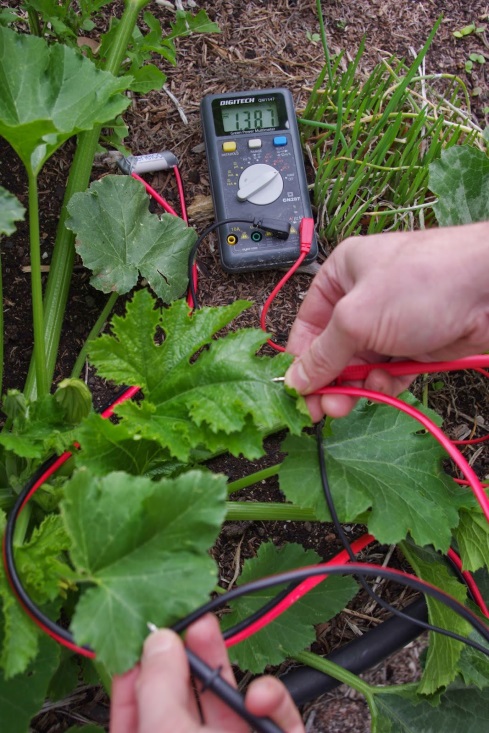 |
| Professor Fuchs of the AIMLESS Institute demonstrates the energy potential of the new GM zucchini and Boozit capacitor |
* On a serious note – This article is purely satirical and any reference to real people or entities is unintended and pure coincidence. Apologies to all serious people out there on the Internet!
Posted by Cherokee Organics at 20:18 5 comments: ![]()
Monday, 12 January 2015
Last week was just hot. After a few days of intense heat, even the bees were constantly going in and out of their hives just to get some fresh air – even though that was hot air. With the coming of the heat, the forest smells beautiful and anyone who has experienced the rich oil smell of a Eucalyptus forest will know what I mean. Every couple of steps there is a completely different scent. Near the bee hives on those hot days you can smell the rich and sweet earthy smell of honey combined with beeswax. A friend recently introduced me to unfiltered honey and that is the closest smell to that of a raw beehive.
The new bee colonies are in a good paddock now as they get the morning sun and the afternoon shade. This was a crucial learning experience for me because last summer after 3 days in a row in excess of 40’C (104’F) in the shade, the wax on the bee frames in those older colonies melted and the bees just departed to cooler parts of the forest. They haven’t gone far, because the worker bees from the now feral colonies still come to visit and I’m genuinely happy to have a few feral European bee colonies located in the nearby forest.
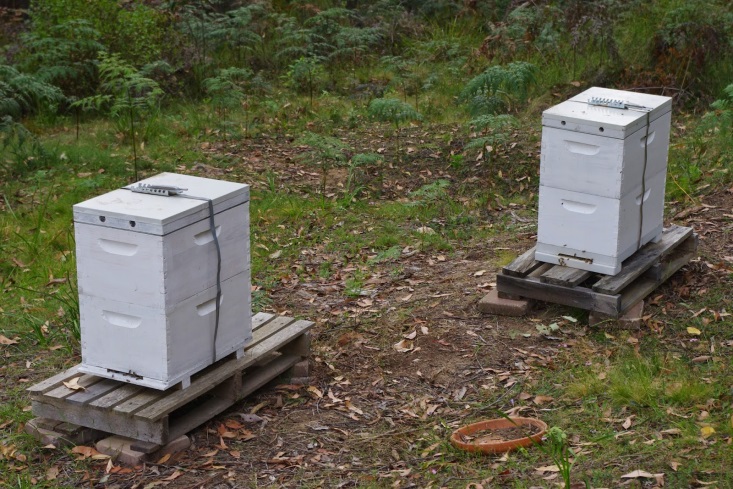 |
| Bees coming and going from their hives to get a taste of fresh air |
Maintaining bee colonies is quite a humbling activity, because I realise that the more time that I spend with them, the less I actually know about them. Should you ever decide to keep a colony or two of bees, then prepare yourself to be inundated by well meaning, but otherwise annoying people providing all sorts of conflicting advice on beekeeping. The only advice I would ever provide people about maintaining bee colonies is to read as widely as possible about the subject, but otherwise listen to what the bees have to say about the world that you’ve dropped them into. That sounds a bit hippy-dippy, but the bees will let you know if something is wrong and generally (trust me on this) if they’re unhappy they’ll sting you.
As the farm has a diversity of flowers which bloom at different times of the year, I’m always observing the bees to see which flowers they like. This week, the bees have been harvesting pollen from the carrot and fennel flowers. What is really interesting is that they (and many of the small birds here) have been gathering nectar from the many geranium (pelargonium) species in flower. The good thing about this is that those species pretty much flower here for most of the year.
 |
| Bee on fennel flower |
If you fail to observe the pollinating insects on a farm, you are definitely courting trouble. Speaking of which, last week in South Australia due to the intense heat and winds, just outside their capital capital city there were some pretty serious bushfires: http://www.abc.net.au/news/2015-01-05/quotes-and-pictures-from-adelaide-hills-bushfires/5999308 . Spare a thought for the regular commenter Angus who lives not too far from there. Even though I’m at least a very long day’s drive from that part of the country, the smoke was clearly visible here and at night it turned the setting sun bright red.
 |
| The sky here turned red at night due to the smoke from the bushfires in Adelaide, South Australia |
On a more upbeat note, the harvest of fruit is still underway and the thornless blackberries are only a week or two away from being fully ripe. I’ve also picked a good crop of apricots from those fruit trees – which it should be noted are only in their second summer in that particular location.
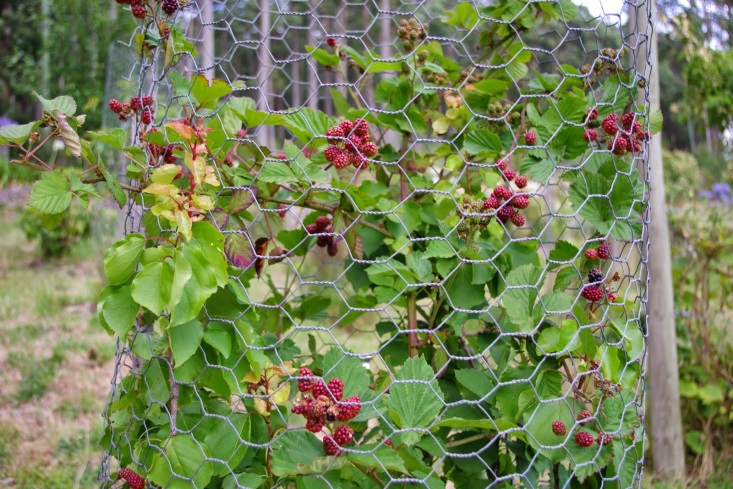 |
| The thornless blackberries are ripening and are only about a week away from harvest |
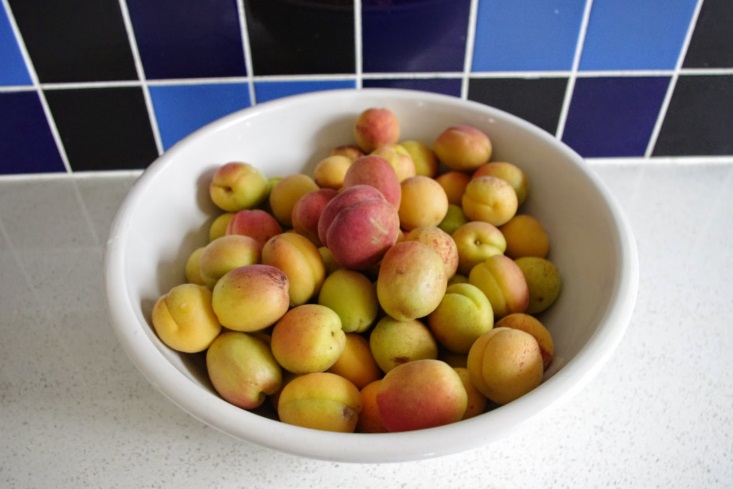 |
| The second year apricot trees have produced a bumper crop this year |
Even though it is getting hotter and drier on the farm as summer progresses, some of the native grasses are producing the most amazing displays of flowers. They’re an interesting grass because they stay green even over the hottest and driest summers and the flowers put on a good show.
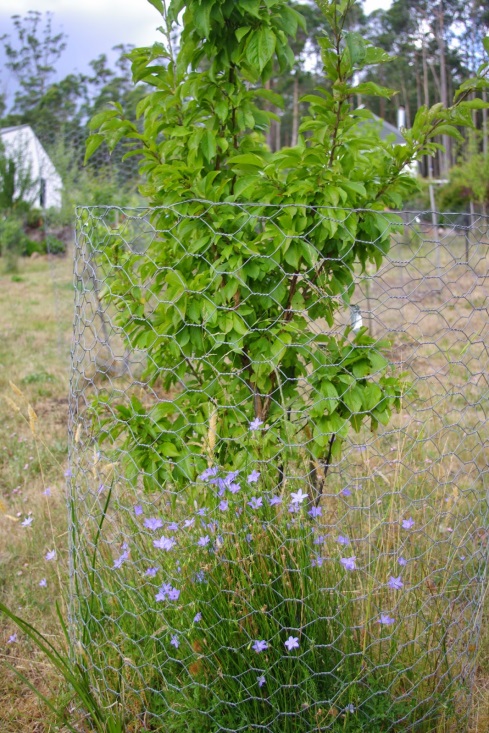 |
| Native grass in flower underneath a Crimson Glo Plum |
The recently purchased electric chipper was put into action this week. I converted the following cuttings of plants into mulch chips:
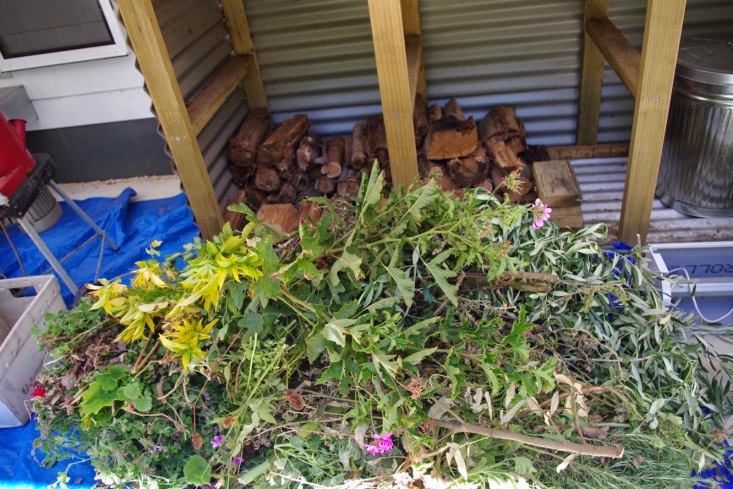 |
| Pile of cuttings waiting to be chipped by the electric chipper |
The surprising thing was just how small a collection of mulch chips all of those cuttings ended up making:
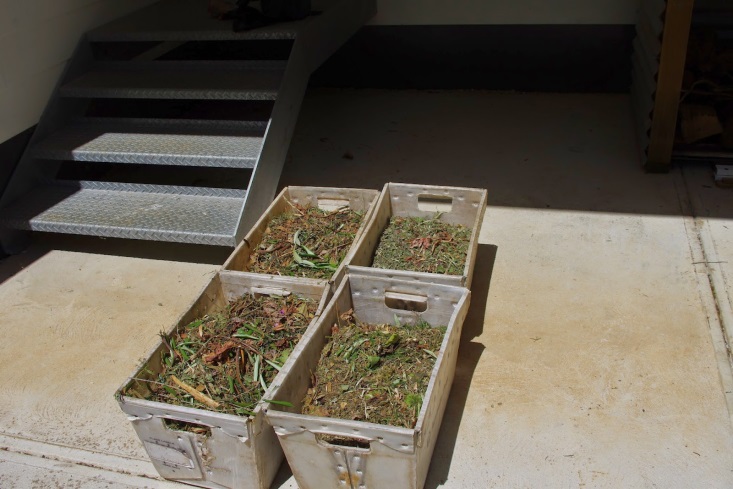 |
| The mulch chips waiting to be distributed |
It was a surprising experience because when I transport in 1 cubic metre (35.3 cubic feet) of woody mulch or compost, that usually provides at least 30 of those same crates. I was starting to get an idea about just how much material I’ve brought onto this farm over the years.
Speaking of which, I’ve had to closely watch the weather forecast because a massive tropical monsoon was working its way down south to the farm here. In preparation for that tropical rain event, I’ve brought in about 6 cubic metres (211.8 cubic feet) of woody mulch and compost and spread it around on the garden beds. All of that organic matter absorbs water like a sponge but also later provides a blanket over the top soil so that the heat is reduced. As the stuff breaks down too, it provides excellent feed for the trees, flowers and herbs. In the photo below you can also see the storm clouds gathering above the house over a newly mulched area.
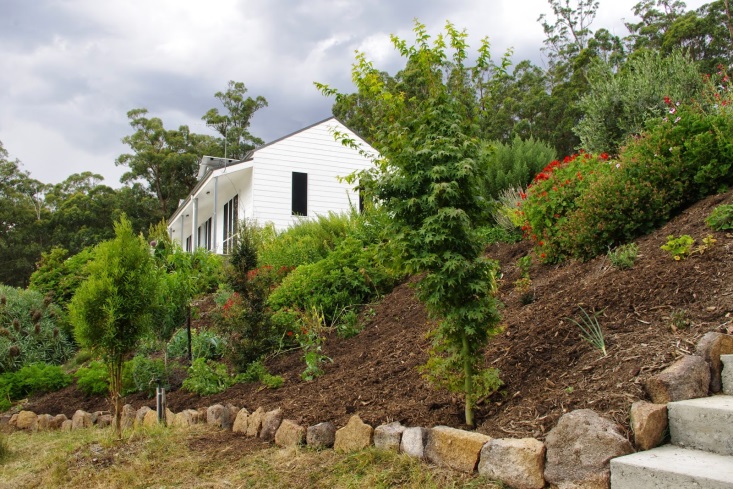 |
| Storm clouds gather over the house from the tropical monsoon |
And then the storm moved in and the rain fell in a drizzle for two days. I captured a photo of this spiders web which was abandoned by its maker:
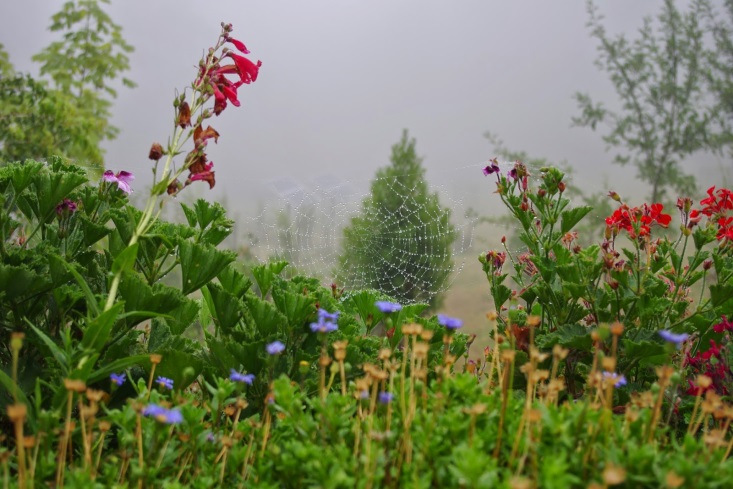 |
| Spiders web abandoned by its maker as the tropical monsoon moved over the farm |
For two days, visibility was down to about 15m (about 50ft) in any direction and the solar photovoltaic panels produced barely half an hours production in an entire day.
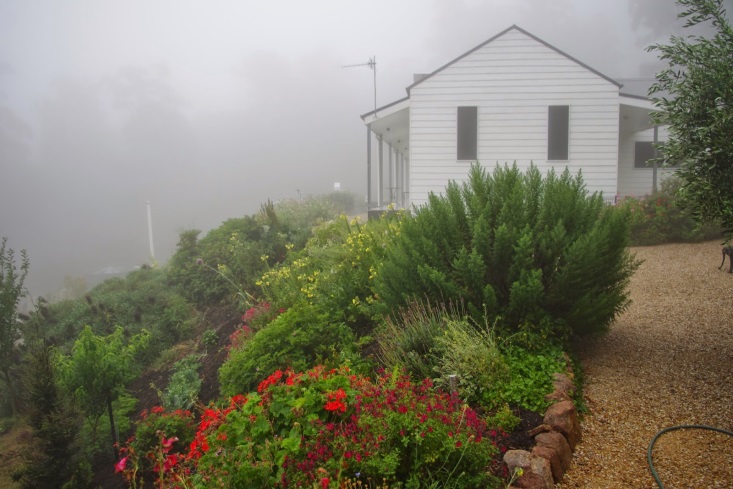 |
| As the tropical monsoon moved in visibility closed in to 15m (50ft) |
The house has deep verandas and it is always interesting during wet weather to see what has crawled under them seeking protection from the storms. You can always count on finding worms, frogs and spiders, but this time the Bogong moths were also hiding there.
 |
| Bogong moth hides from the rain under the shelter of the veranda |
I rarely plant new plants at this time of year because the survival rate is so low, however because of the heavy summer rain, I went with my gut feel and headed out and purchased some new and interesting flowering plants and herbs. Usually autumn is the best time to plant here.
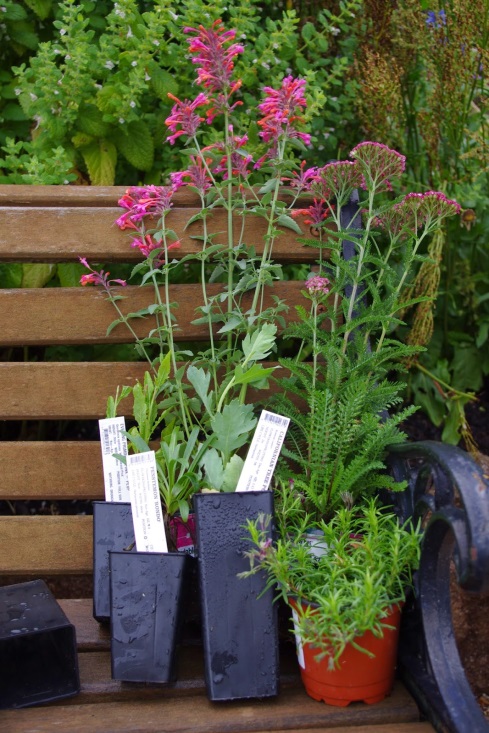 |
| New flowering and herb plants waiting to go in the ground |
All of the plants are responding well to the increased level of soil moisture and humidity and one of the most beautiful is the globe artichoke. Those plants are not only virtually indestructible and easy to propagate, but they are very tasty and produce the most amazing flowers:
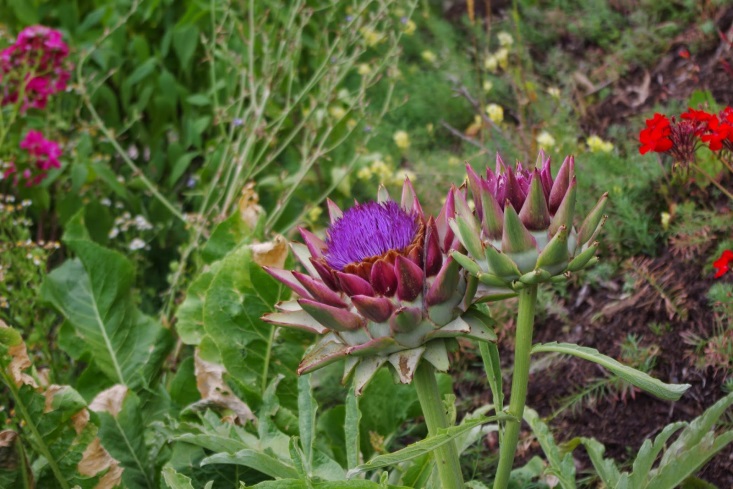 |
| Globe artichoke in full flower |
I’m not really courting trouble – at least that I’m aware of, but speaking of the courtyard I’ve constructed a few more steps on the staircase leading up from the courtyard. Eventually I’m hoping to establish a potato and another strawberry enclosure near the top of the staircase. The stairs are a great project to do during the sort of turbulent weather that the farm is currently experiencing. When weather conditions are less than optimal, you can build a step and then retreat into the house. I’m amazed that I’m now up to the thirteenth step and there are still a few more to go before completion.
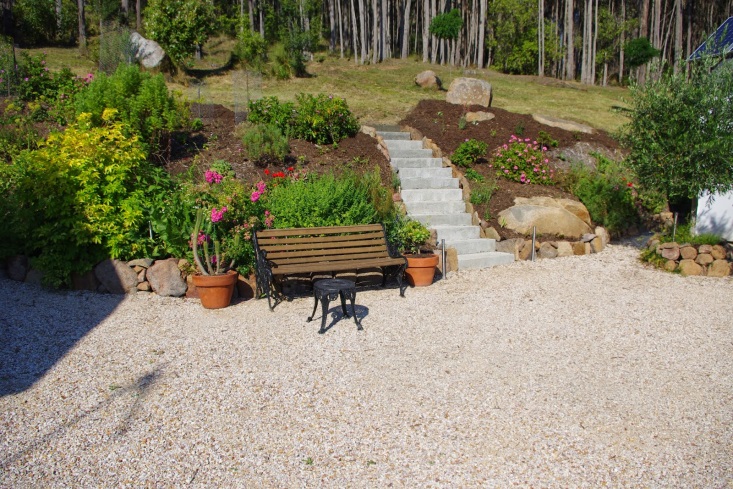 |
| The steps from the courtyard are getting higher with each week |
How did I get here?
So I kept on moving houses and either repairing them or building them completely from scratch. A lot of people are troubled by moving houses, but in my life to date I’ve lived in 19 different houses, so it is no trouble to me to change address. That actually sounds like quite a lot of moves, but many of those were before I was an adult.
Having lived in so many different houses over the years, I’ve seen pretty much every type and era of housing that is to be had in this state. Having worked on many of them either repairing or rebuilding, I’ve developed a sort of feel for how that style of house is going to perform in different weather conditions.
One of my favourite houses was an old double brick terrace house that dated back to 1890. When we moved into that house there were floors in only two of the rooms. The electricity was interesting because there was only a single power point in the entire house and absolutely no lights at all. The bathroom and toilet were in the backyard and the steel water pipes were so clogged by a build up of calcium inside the pipes that they produced a strange and unusual cloudy water. We eventually took the entire house back to a brick shell and rebuilt it whilst at the same time correcting the rather unusual problems that were part of its sad state. Still, it was only hard work and wasn’t that different from camping (initially anyway).
It was worth mentioning that all the work on the houses was done whilst we were both employed full time and also often studying part time at various points during those two decades. The only reason that it was at all possible to juggle all of those different activities and maintain a social life was because my wife taught me how to study effectively. The funny thing about University is that a person simply starts the process and there is no guide to how to go about getting through that process. Such a guide would probably be beneficial to students. I was always a good student, but my methods were very ineffective and very time consuming. My wife simply taught me the most expedient method of getting through that process, whilst also obtaining excellent results. I owe her a debt of thanks for that lesson.
The good thing about knowing how to learn quickly and effectively is that you can apply that technique to different aspects of your life and so I did with houses.
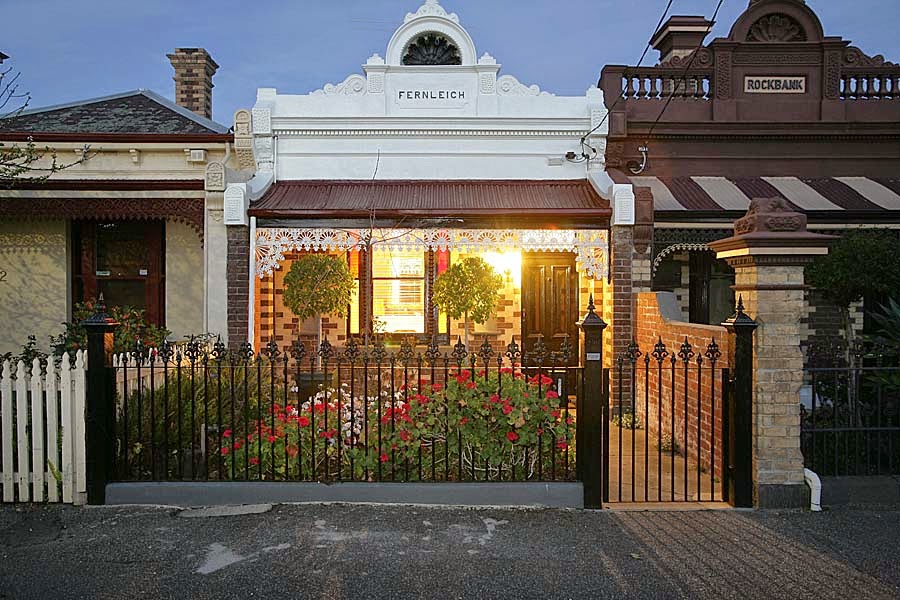 |
| I even rebuilt the front iron fence and you can see I liked geraniums back then too! |
To be continued…
The temperature outside here at about 9.00pm is 25.3 degrees Celsius (77.5’F). So far this year there has been 37.2mm (1.5 inches) of rainfall which is up from last week’s total of 7.2mm (0.27 inches). Apparently the tropical monsoon will swing back south and hit the farm with a 90% chance of between 20mm to 40mm (0.7 inch to 1.4 inches) tomorrow morning – but you wouldn’t know it by sitting in the orchard writing this on a warm summers evening.
Posted by Cherokee Organics at 21:46 40 comments: ![]()
Monday, 5 January 2015
Everything including the squeak
Happy New Year everyone!
Waste doesn’t excite me. The farm is located in a remote spot that historically didn’t support much of a human population – so my thinking is that if you have gone to all the effort of bringing materials up here then those materials might as well find some sort of use. The old timers used to say that when they butchered an animal, they used everything including the squeak. That is an excellent rule by which to guide your scrap collections.
Last week I scored some free tomato plants. This posed a problem because I had to then clear out a raised garden bed (which provided great chicken feed – squeak!) so that they could have an area to be planted in. Then a structure had to be built so that those new tomato plants were supported as they grew in height. If the plants were not supported, they would fall over (the technical term is called “lodge”) and any tomato fruit growing at ground level may promote disease. It also allows every ground dwelling insect on the farm to acquire a good taste for ripe tomatoes. I won’t mention that the dogs here also tend to urinate on the plants at ground level in order to mark out their territory. This act alone leaves me with a sort of “yuk” factor whereby I consider the fruit to be unpalatable.
After a bit of delving into the spare pile of steel angles and reinforcing mesh, I produced the following tomato plant supports:
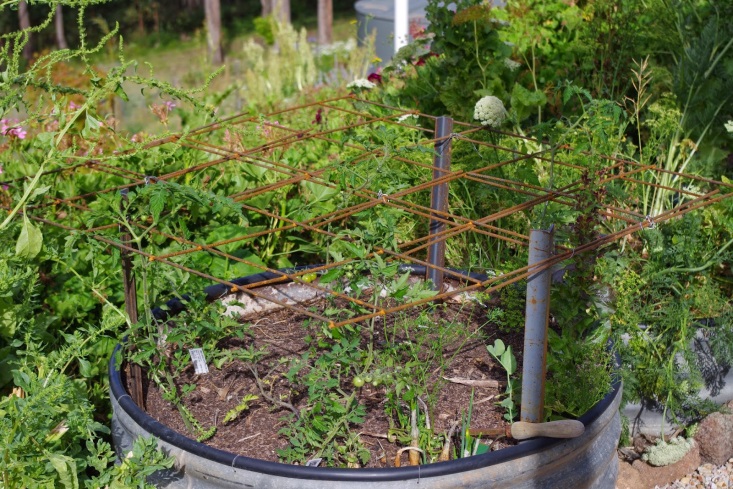 |
| New tomato bed with freebie plants and supporting steel mesh |
It is great to be able to delve into your pile of scrap materials and produce something of use (what I call squeaking). However, it would be very easy to keep every single chunk of scrap that you can obtain and there are certainly a few farms around here that resemble junk yards, and am ruthless in that I try to only keep scrap that can be possibly reused in the future. This also means that I also have to store that scrap carefully so that it will be in a condition to be used when called for.
Did I mention that this week at the farm it has been hot here, with two days in a row in excess of 40’C degrees (104’F)? It is worth mentioning that those temperatures are recorded in the shade. In the direct sun it is just so much hotter again. At about 6pm on the 2nd of January my weather station (I truly enjoy this bit of technology) recorded the following temperatures (the house does not have an air conditioning system so the inside temperature is a result of heavy insulation):
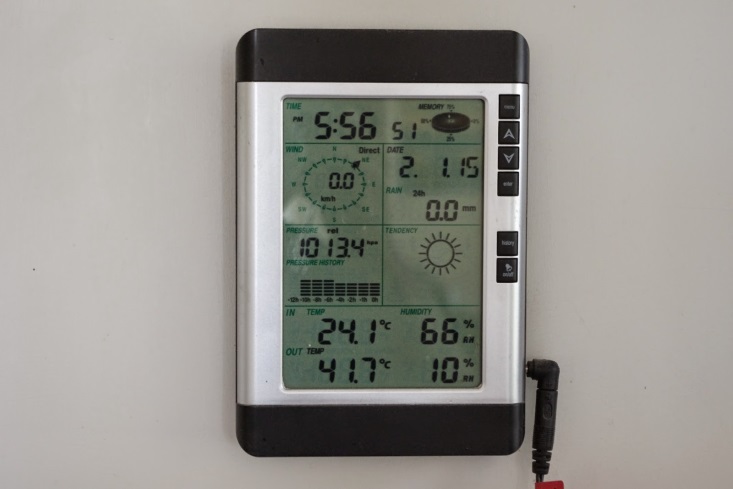 |
| Weather records at the farm here on 2nd January 2015 |
Due to the heat, there have been significant and early grass fires to the west of the farm too, so any people affected by those fires have my sympathies.
The plants on the farm here generally survive on rainfall alone so they are mostly adapted to drought conditions and can usually endure the hot weather far better than I do! The photo below shows the plants at the rear of the house on the very steep cutting after the two hot days:
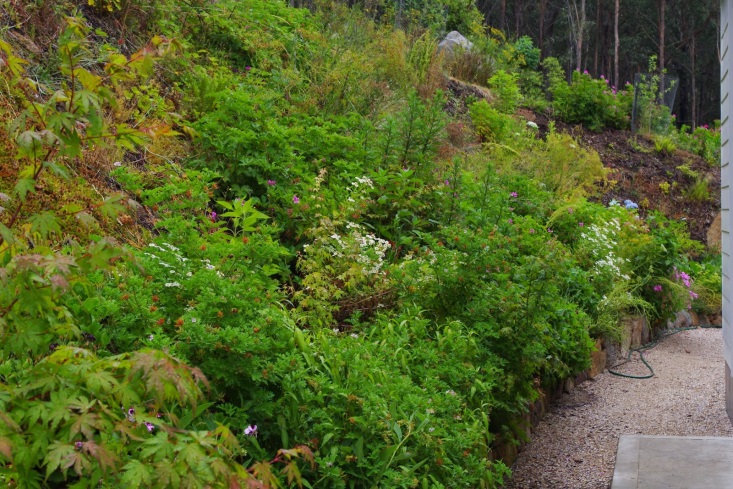 |
| Plants on steep excavation after two very hot days here in excess of 40’C degrees (104’F) |
The great thing about weather forecasting is that you obtain a few days’ notice if such extreme weather events occur. That forecasting allows you to alter the projects that you work on so that you are not working in the full sun for hours on end.
A few weeks ago, I slipped over and fell whilst mowing a patch of herbage above the cantina shed. In the process I hurt both my back and arm. Whilst my body quickly repaired from the fall, the thought occurred to me that it could have been much worse and it probably may happen again in the future. So I had been thinking to myself that a set of stairs leading up into that area above the cantina shed might not be a bad idea.
Making concrete steps is no easy task, however it is a good task to do whilst the weather is so extreme because you can work outside for a few hours, retreat into the house to cool off and then go back outside and build another concrete step later in the day. The concrete steps are also a great use for more squeakers (sorry, I meant scrap items) and I added many small rocks and offcuts of steel reinforcing mesh into them too.
No projects here are ever simple, as I had to remove some healthy plants from the area where the stairs would go. At this time of year I give those plants which were transplanted about a 10% survival rate. However, I consoled myself with the thought that they certainly wouldn’t have survived being concreted over! I then put in the first few steps and added some garden LED bollard lights:
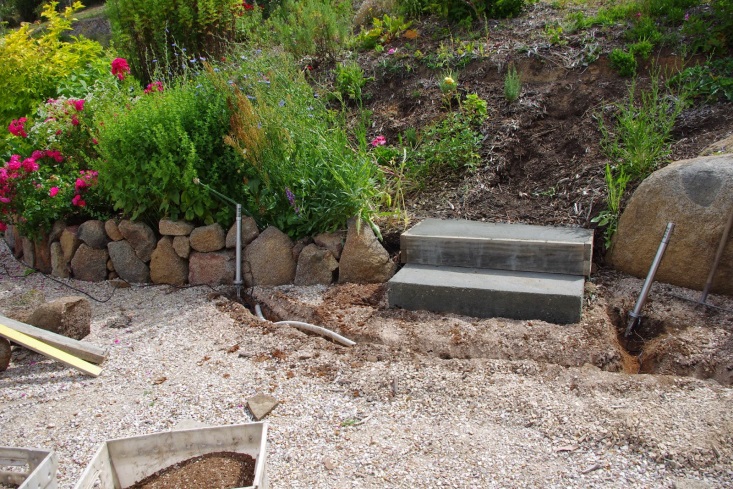 |
| First few steps in the new set of stairs and trench for the LED bollard lights |
All of the concrete was mixed by hand in my trusty steel wheelbarrow. Seriously, I keep expecting that old wheelbarrow to fall apart one day because of the punishment it receives here, but it just keeps sort of holding together. In turn, I keep using it. When the wheelbarrow eventually dies, in recognition of how hard it has contributed to the farm, it will be somehow incorporated into the garden as perhaps a succulent raised garden bed. If anyone has any suggestions, I’d appreciate it?
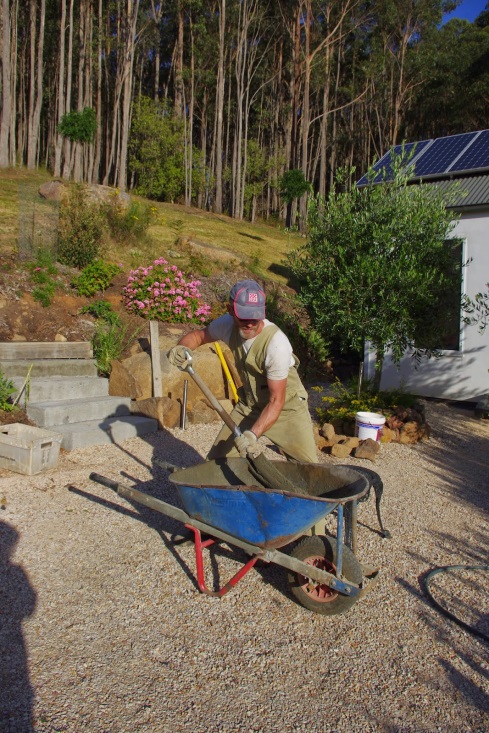 |
| Trusty wheelbarrow in action used to mix concrete for the new steps |
Anyway for those that are technically minded, I estimate that by the time the concrete stairs are completed, they would have absorbed: 1 cubic metre (35.3 cubic feet) of sand and aggregate mix (i.e. sand and small stones) as well as 320 kilograms (705 pounds) of concrete mix. That doesn’t include the many countless local rocks and scrap squeaks (sorry, I actually meant to write steel)
Fortunately, after the extreme heat came a cool change with a bit of drizzle and 7mm (0.27 inch) rainfall.
As the week progressed, the concrete stairs kept climbing slowly higher. The first step was deliberately brought forward of the existing rock wall so that rock wall had to be rebuilt too. Additionally a new rock wall was built to the right hand side of the stairs in front of a very large rock – which unfortunately can’t be moved or broken up without some serious explosives!
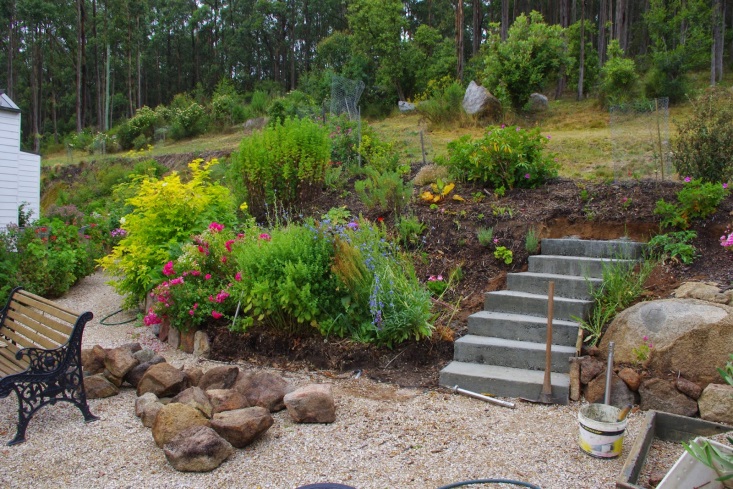 |
| The concrete stairs are getting higher and the rock walls are being rebuilt |
As of today the concrete stairs are now at approximately their half way point and the rock walls have been fully rebuilt. Also during that process I removed any undesirable plants from those garden beds and fed the soil with 1 cubic metre (35.3 cubic feet) of woody mulch and mushroom compost. Yay!
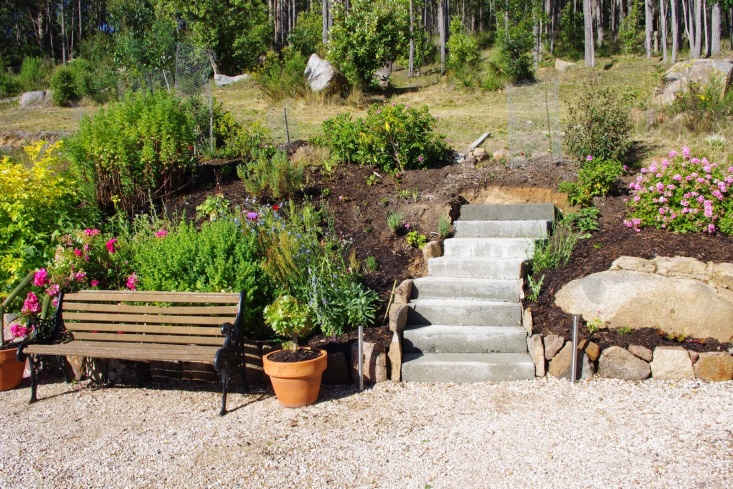 |
| Concrete steps at their half way point |
I must have rocks in my head (pun intended) to be working outside in such heat, but in other activities, I also mostly completed the rock wall below the cantina shed. That area has yet to receive a thick layer of the woody mulch and mushroom compost mix, but will over the next few weeks. I’ve already begun planting that area out with cuttings and self-seeded plants. Also this week I noted that the large Echium plant in the photo below had self-seeded and there are now a few plants to move once autumn arrives.
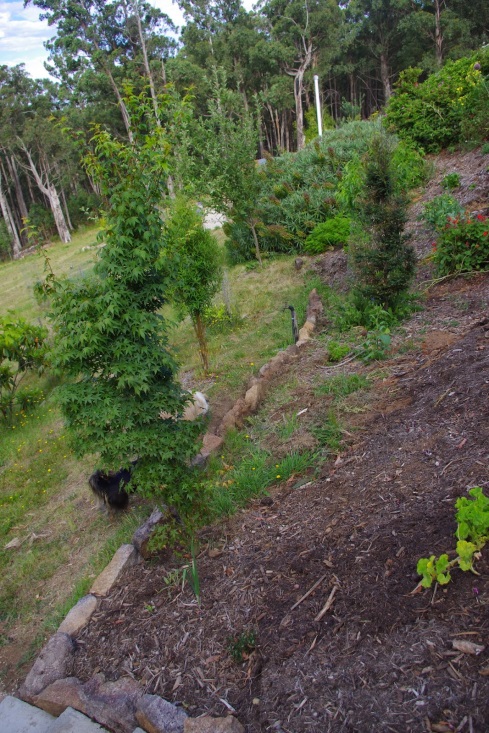 |
| rock wall below the cantina shed is nearing completion |
A few weeks ago, I mentioned the necessity to have an area set aside purely for the unloading of materials. In the photo below, the mulched (dark) area is used for that purpose. In the past the rock wall was too low because the original rocks were too small. This week, I removed all of those small rocks, included them as squeak (sorry, I meant fill) into the concrete steps and rebuilt the rock wall with much larger rocks. The larger rocks are useful because they reduce the spillage of materials when they are unloaded.
 |
| Area set aside for unloading materials |
On a completely different note, a few evenings ago as I was in the orchard on a hot evening supervising the chickens, I startled a very large wombat happily munching on some greens:
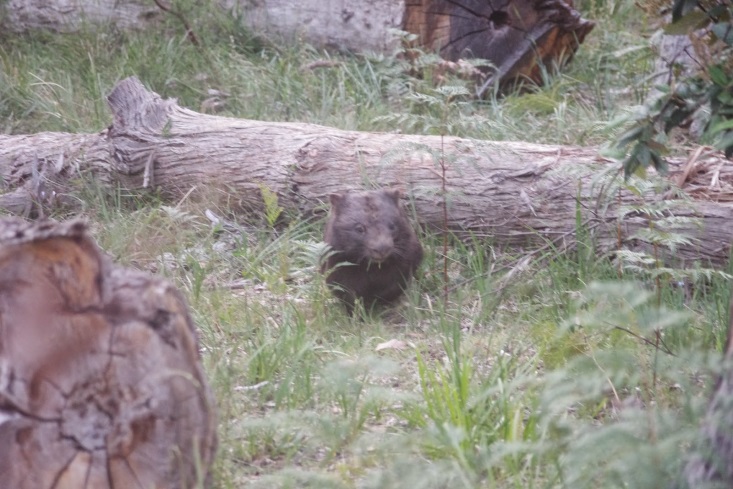 |
| Wombat happily munching on some greens |
After all of that hard work in the hot summer sun, I felt like a day off today. So, I packed up the car and headed off to visit the Serendip Sanctuary which are manmade wetlands and a haven for many species of birds in the area. There are quite a few wetlands to the south west of the farm and many are of international importance. At this time of year the magpie geese were out in force:
 |
| Magpie geese enjoying the conditions at Serendip Sanctuary |
I also happened to spot an emu enjoying the herbage growing in a dried up lake bed at the Sanctuary:
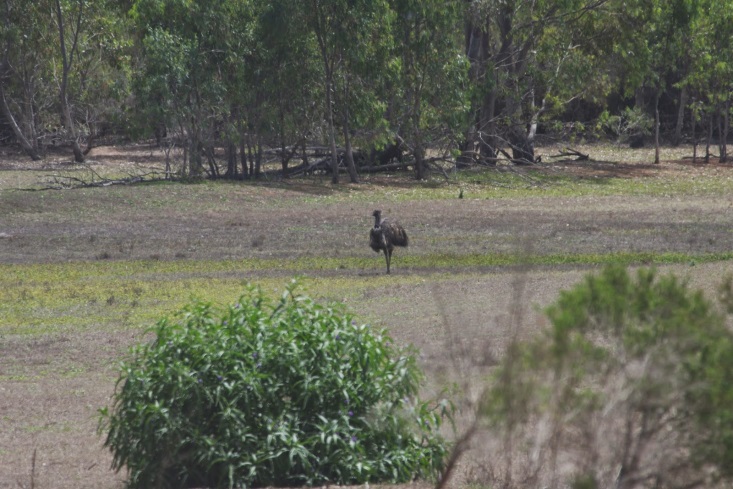 |
| Emu enjoying the herbage in a dried up lake bed |
How did I get here?
For some reason I am unconcerned with status. When my lady and I married we purchased a house in the – then – cheapest inner city suburb of Melbourne. As it was the recession at the time with over 10% unemployment and we both lived in fear of losing our jobs, the chosen house was a – to put it politely – a bit of a dump. Fortunately, that made it cheap.
The hard lesson that I learned from that experience was that other people are actually concerned about status. They expressed their distaste for our choice of suburb by disdainful and generally mean comments, plus all the usual wrong side of the river sort of rubbish. Some people refused to even cross the main bridge linking Melbourne to the western suburbs as if they’d feared catching some sort of disease in the process. Still, it may well have been fear of that bridge collapsing – well, it’s not as if it hadn’t already happened during construction of the bridge!
The house was a good timber starter house. The back half was sinking into the local clay. It had no laundry. The toilet was in the back yard. You know the usual stuff that makes a house a good starter house.
Being of a practical mindset and knowing absolutely nothing about houses at all, I decided – yeah I can fix this house and make a few alterations. Possibly it may have been a bit ambitious but slowly through reading books and snooping through construction sites, I learned how to fix the house. I’m not just talking cosmetic stuff either, as at one point I used bottle jacks to lift up the house whilst I crawled around underneath in the mud replacing the worn timber stumps (which are used to keep the house off the ground) with concrete stumps. It was lots of hard work but also lots of fun.
After a few years of this, I sold the house and found that I still had far more to learn, because I lost money in the process. I was really annoyed, but put the experience behind me and moved on.
To be continued…
The temperature outside here at about 9.30pm is 18.5 degrees Celsius (65.3’F). So far this year there has been 7.2mm (0.27 inches) of rainfall. Last years rainfall was 819.4mm (32.25 inches) which is not far from the long term average.
Posted by Cherokee Organics at 21:41 ![]()